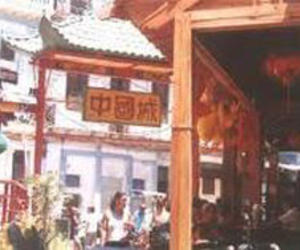Havana's Chinatown
- Submitted by: manso
- Editorial Articles
- 02 / 08 / 2011

February 6, 2011. Havana's Chinatown has a long history behind it. It is part of the life of the capital, in the same way that migration and culture of the Asian country have qualified the Cuban idiosyncrasy and enriched their crossbreeding.
The first Chinese settled in Havana in 1858, were Chang Leng, a small inn, and Siu Lam Yi with fruit and vegetable stand in the current Ditch Causeway. Some former coolies, through their own efforts, had learned various crafts to the public service.
At that time no other area of the capital's center that offered better conditions called Ditch Real, conceived after 1550, where the water reached the population, according to Baldomero Alvarez Rios.
In that area was installed a stop train carrying passengers to the Racecourse Marianao. With these possibilities Chinatown continued to grow and spread in several directions.
In the early twentieth century and living in 10 blocks in this area about 10 thousand Chinese. The initial area covered from Galiano (formerly Avenida de Italia) to Loyalty. And from queen to Belascoaín. If the heart of Chinatown was the street trench can be estimated that the Dragons are more typically was and is China where the majority of societies.
In Chinatown began to swarm a small shop from inns and laundries, shoe repair, watches and other trades. Also holds for retail food sales, sale of poultry and fish dry, pharmacies with exclusive products imported from the rich and ancient traditional Chinese medicine, silk, shops, restaurants, newspapers, radio programs, theater for opera performances in Asia. And many companies training and recreation, some established in the houses of the Chinese.
In the first decade of the sixties of the nineteenth century, flowed into the island a wave of Chinese residents in large regions of the state of California,in the Pacific of the United States where they had come during the "gold rush."
The motives of this exodus were riots and violent riots by labor disputes, but the flow never stopped.
"To complete the picture of the cities within the city," says Alejo Carpentier,one must say that Chinatown, "from the time called Dance of the Millions, took an enormous importance: it is filled with very rich merchants.
"There were celebrated the festivals of the dragon, and the Shanghai Theatre was one of the most extraordinary Chinese theaters in Latin America, comparable only to San Francisco. In this neighborhood pharmacy with a medication were rare, magical for pain head. Many Chinese came to be so rich that hired the most famous companies in Guangzhou and Shanghai and San Francisco. "
The number of descendants of this ethnic group who migrated at this stage is estimated at 10 000, many of them belonging to a generation that available financial resources. They came through Mexico and New Orleans and settled in homes of wealthy clients, owned by three bankers: Lam Ton, Shan and Lay youI Weng.
In March of 1870 opened the first store selling imported goods from Asia in a room at Sol y Villegas in what today is the historic center.
Years later, in 1874, opens another trade category, in Chinatown, the Council Tong Sang, which invested 50 thousand dollars, a figure respected in those days.The owner brought a recipe with more targeted to the tastes of the Cubans,lovers of sauces, condiments and spices.
Thus arose the famous Chinese food, especially the shop Shuey with vegetables and meat, and finally the famous fried rice, perhaps one of the few foods invented in Cuba: rice fried in a pan and cooked cuts of meat, bean, chive , soy sauce in China. This dish is accompanied with their respective "butterflies."
Then they began to proliferate diner without much fanfare, but with great authenticity and acceptance (as was the case of La Bodeguita del Medio). Pullman founded the Chinese, La Muralla, Daytona, Canton, all of them were strong competition to the best menus prepared in lavish restaurants.
In the Plaza del Vapor China ate soup and fried rice very cheaply available to all: in its infancy, with only ten cents a fried rice was consumed first.
Crowning the Barrio Chino, Ray Street and St. Nicholas (in the Chinese knife),stood the most famous of its restaurants, the Pacific, founded by brothers Font,in the 1920's with four levels (later in 1940 I added the fifth).
This restaurant deserves separate chapter. It's like the highest temple in Chinatown, the Sistine Chapel of Asian food: smoked meats, fish sauce, popcorn,chips, corn chowder soup, Manju fried Chinese cundiamores, shark fins, cilantro, collard greens and oyster sauce .
In a new restaurant-with prefab techniques widely used in tourist centers, could rescue the fifth floor, where it looked all over Havana, and especially the entry of ships through the bay. The windows were huge and provided to the guests the feeling of being aboard a huge ship.
Armando Chang (Cuango Shu King) had in 1943, the Causeway, where he still resides Ditch-china pharmacy offering a variety of medicines imported from the Far East: syrups, antidotes to pain, fever, stomach problems, genital tonic,seahorse tiger and even eggs.
To make the magic touch was the religious syncretism of San Fang Kong (Santa Barbara and Chango), a historical figure with the rank of general in the third century AD, was beheaded in an ambush. He erected a temple at the site of the tragedy. So began the legend that it was becoming a saint. How his real name was Kung, but it was breaking down in successive mutations to become San Fang Kong.
The theater, music and dance China also deserve a separate chapter. There are still thousands of Chinese arts, rescued every day. Chinatown lives, develops,is one of the sites most visited by tourists and Cubans. In his great moment was the largest Chinatown in Latin America.
Source: http://groups.yahoo.com/group/CubaNews/message/120814
Comments